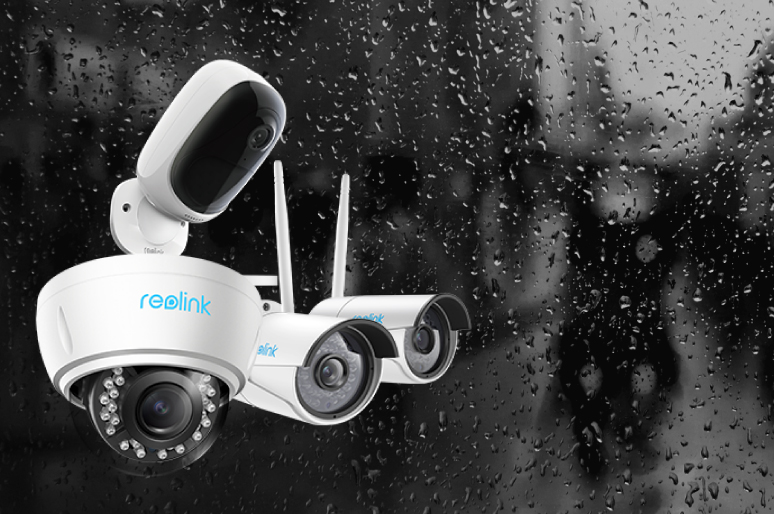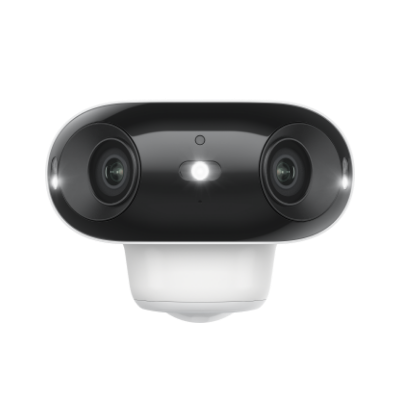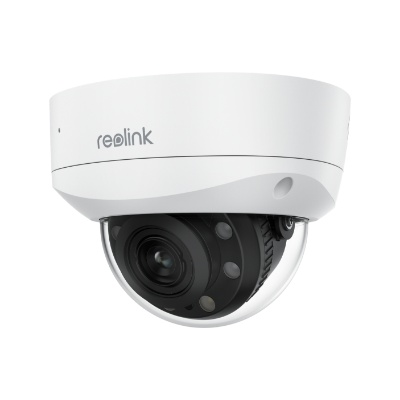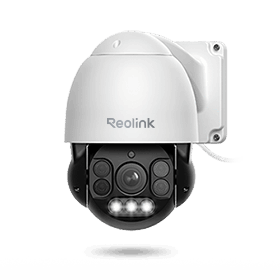IP66 Cameras: Definition & Recommendations

The IP66 cameras can withstand different weather conditions, such as heavy rain or solid dusts. That’s what most IP66 camera producers advertise, and probably pretty much all you know about them. And that’s not enough! Actually, IP66 is just a rating that indicates the dust and water resistant level of the enclosure, and there are other similar types like IP67, IP65 and IP54 cameras as you may see on the market.
So what does ip66 rated mean exactly? Is IP66 waterproof? Could the IP66 CCTV cameras stand the heavy rain, strong wind or terrible snow in your area? Is there any big difference between IP67 and IP66 security cameras and which one should you invest in? Find all the answers below in minutes.
IP66 Camera Definition – What Does It Mean
An IP66 camera is the one that has a solid housing that provides complete protection to the dust and powerful water jets, meaning it could stand the heavy rain, wind and snow outdoors.
Actually, the IP rating, International Protection or Ingress Protection Rating, is a standard that indicates the level of protection against dust and water provided by the enclosure.
Technically, each digit in the IP code has its specific meaning:
- The first digit represents the level of protection against solid objects;
- The second digit represents the level of protection against fluids.
Generally speaking, the larger the number is, the higher level of protection provided, as the chart below shows.
Note: X means no data available to specify the rating instead of no protection. Actually, they are higher protected than level 6.
IP65 vs. IP66 vs. IP67 Cameras: Which One to Choose
You may see IP54, IP67, IP65, or IP66 cameras on the market claiming to be waterproof. But there could be huge differences between them – as the chart above suggests. Generally speaking, the IP65 (battery powered ones) and IP66 cameras would be no mistake in any environment, and the IP67 cameras could be overkill for home use and not a cost-effective option.
To be more specific:
-
IP66 cameras, also called IP66 waterproof cameras, are the most common ones, and they are completely impervious to natural elements. That’s to say, you can place them outdoors in any weather condition like the extensive rain or heavy snow, even in Canada and Russia.
-
IP65 cameras, or so-called weatherproof cameras, are also popular, especially in the battery powered cameras world, and they should be enough to guard your house or establishments in the rain and shine – as long as there is not extensive rainfall in months.
-
IP67 cameras are not very common in security cameras and you’ll find them more cost-effective if you have specific uses, like monitoring things under the water.
-
IP54 cameras could only protect the camera from splashing water, which is far from enough to resist powerful rains. So it’s advised to find a shelter for the IP54 camera if you use it outdoors.
Here is also a comparison chart for your reference.
Whether to go for IP66 security cameras or IP65 ones actually depends on what kind of security cameras you are looking for. Most outdoor battery powered cameras are designed with a special plastic casing. For this reason, IP65 cameras are the best you can find on the market today.
While the hard wired or WiFi cameras, which you could normally see on the street and around the neighborhood, mostly come with metal housing, and therefore the IP66 camera enclosure is now the industry leading standard for this type of cameras.
Best IP66 Camera Recommendations
IP66 cameras are the first choice for outdoor surveillance, like the front door, backyard, driveway or the wild, and for the business where the washdown operation is a normal practice.
However, there could be different best matches for different installation place and monitoring purposes.
Best IP66 Battery-Powered 4K Camera – Reolink Argus 4 Pro
4k 180° Wire-free Color Night Vision Camera
4K UHD 180° Blindspot-free View; Color Vision Day and Night; 30% More Battery Life; Dual-band Wi-Fi 6; Smart detection.
As I put it earlier, the highest IP rating you may expect for a battery-powered camera is IP65 and that’s enough to work in most environments, like the dry hot summer in California and the cold moist winter in New York. However, the new Reolink Argus 4 Pro takes things a step further.
So with no compromise in the working environment and no wires at all, this IP66 battery-powered camera offers you the easiest installation than ever before: just put the batteries in, you can place it anywhere you like – even mount it on the tree in the wild with a strap!
For a closer look at the IP66 camera Reolink Argus 4 Pro, check the specification chart below.
For consumers needing full-color night vision without visible spotlights, the Reolink Argus 4 Pro is an excellent choice. Alternatively, those seeking a cost-effective solution that performs well may consider the standard Argus 4 version.
4k 180° Blindspot-free Wi-Fi 6 Camera
4K UHD 180° Blindspot-free View; Dual-band Wi-Fi 6; Smart detection; Easy Installation Anywhere
Best IP66 Dome Camera – Reolink RLC-843A
Smart 4K PoE IK10 Camera with 5X Optical Zoom
IK10 Vandal-Proof, 4K 8MP Ultra HD, 5X Optical Zoom, Color Night Vision
This dome camera settles three big troubles for you, namely the harsh weather, vandalism and complex installation, which offer you a worry-free option:
- It is an IP67 camera that could work well in any weather condition.
- It is a PoE camera which provides a plug and play solution.
- Find more features of this IP67 dome camera in the chart below.
Best PTZ IP66 Camera – Reolink RLC-823A
Smart PTZ PoE Camera with Spotlights
4K 8MP Ultra HD, Person/Vehicle Detection, 5X Optical Zoom, Auto Tracking, Manual Pan & Tilt, Two-Way Audio, 190ft Night Vision, Live View.
Look for IR IP66 camera with exceptional night vision? Reolink RLC-823A is the one. It could see things 190ft away clearly even in low light conditions – that’s where most security cameras fail to work. And it could also do PTZ, which extends its field of viewing greatly and leaves you no blind spots!
Check out the detailed features of this IR IP66 camera via the chart below.
Now watch the suspicious person checking the car at night captured by the IR IP66 camera Reolink RLC-823A.
Top IP66 Cameras Outdoor Installation Tips
Yes, the IP66 cameras are waterproof, which literally means you can put it anywhere outdoors.
Yet, any obstruction on the IP66 security camera lens could affect the image clarity and the IP66 cameras could be more durable with careful installation and placement.
So here we collect some IP66 CCTV camera installation tips for you:
- Place the IP66 weatherproof cameras under the eaves or ceilings, which will make the IP66 security camera less conspicuous and protect it against the natural elements at the same time.
- Build a shelter for the IP66 camera when necessary. You may make use of a plastic bottle, pot or something like that to DIY an IP66 security camera housing.
- Dress the IP66 camera with skins or special housing. For example, some cameras offer various skins with different colors which provide a level of protection and make it easier to hide.
FAQs
Could IP66 cameras stand extreme weather?
Whether the IP66 camera could survive the extreme weather could be the first question that pops up to your mind if you live in Canada, Russia or other cold areas. But no worries, the answer to the above question is absolutely yes! You may be careful enough to find the operating temperature for most IP66 security cameras would be something like -10°C~+55°C, but that doesn’t mean they couldn’t work in harder environments.
Here is the thing: The IP66 CCTV camera working temperature actually indicates the requirement to start the camera.That’s to say, even if your local temperature couldn’t meet the required operating temperature all year round, you could still use the camera by starting it indoors and then moving it outdoors!
What is the difference between IP66 and IP67 cameras?
The main difference between IP66 and IP67 cameras lies in their respective levels of protection against dust and water. The "6" in IP66 indicates that the camera is completely sealed off from dust ingress and can withstand water jets from all directions. The "7" in IP67 means that the camera is still dust-tight, like IP66, but it can also be temporarily submerged in water up to 1 meter (or approximately 3.3 feet) deep for a limited time without suffering damage.
Is IP66 fully waterproof?
IP66 is not considered fully waterproof. While an IP66-rated device, like a security camera, is designed to be highly resistant to water, it is not designed to be submerged in water or to be continuously exposed to heavy rain or water jets.
Conclusion
Overall, IP66 security cameras can withstand harsh environmental conditions and are the ideal choice for outdoor surveillance. They provide an effective shield against dust and powerful water jets. What's the IP rating of your security cameras? Can they withstand dust and water? Tell us about your experiences, and share this article with your family and friends if you find it useful!
Search
Subscribe for the Latest Updates
Security insights & offers right into your inbox




